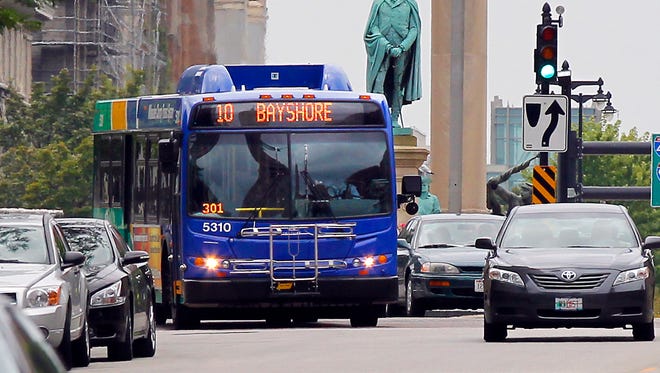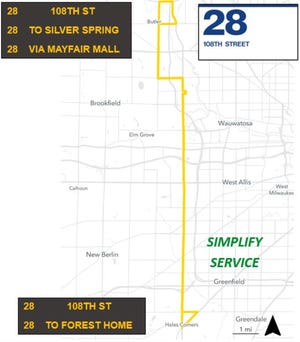
The Milwaukee County Transit System will be implementing new route changes later this year, and officials say last year's changes increased ridership and racial equity.
MCTS hosted public hearings in recent days where officials shared plans and allowed for public input. As part of the hearings, MCTS also shared quarterly results.
Last year, MCTS implemented a three-phase change to routes, a process they have called MCTS Next. Statistics provided by MCTS show that the implementation was an overall success.
Generally speaking, ridership declined during the COVID-19 pandemic. In 2019, MCTS averaged more than 79,000 rides a day. However, in 2020, that number dropped to less than 43,000 and declined even more in 2021.
Statistics on ridership from the first quarter of 2022 compared to the first quarter of 2021 shows an increase in ridership for the first time since the pandemic.
From 2021 to 2022, system ridership increased 15% or roughly 6,000 rides a day, while ridership increased 10% on high frequency routes, according to MCTS.
MCTS last year increased the number of high-frequency routes, which are routes that run more buses so that travel times and wait times decrease.
MCTS also found that ridership on routes that primarily serve people of color increased 17%, or roughly 5,000 rides a day from 2021 to 2022.
An annual survey administered by MCTS found that 75% of riders reported MCTS exceeds or meets their needs, while nearly 70% of riders reported they feel the frequency of service developed during MCTS Next exceeded or met their needs.
The last phase of MCTS Next was implemented in August of last year and MCTS is now making adjustments to routes based on public input.
"Our goal is to really either expand the frequency or make them easier to understand," said Jesus Ochoa, planning manager at MCTS.
Here are the nine routes set to be adjusted starting August 28:
Route 18 —National-Greenfield

High-frequency service will be extended west along Greenfield Avenue from 84th Street to Highway 100 along route 18.
A new service will be provided to Beyond Vision's new VisAbility Center at 108th and Lapham Streets. The 130,000 square-foot facility, currently under construction, will provide jobs to the vision impaired and, potentially, new or existing bus riders. "We are really stoked about that," said Ochoa.
Route 18 service on National Avenue will be replaced with an extension of Route 54 from Mitchell and Burnham Streets.
Buses will continue to run from 5 a.m. to 1:30 a.m. (no change).
Route 54 — Mitchell-Burnham

Service will be extended further west for Route 54 along National Avenue to 112th Street. Currently, it ends around 70th Street.
The new service will replace Route 18 buses that are being moved from National Avenue to Greenfield Avenue.
"This proposed change was actually something that our customers actually asked for, they wanted that one bus ride further," Ochoa said.
Frequency will be increased on the weekend from a 45-minute wait to a 35-minute wait. Weekday buses will continue to run every 30 minutes.
Buses will continue to run from 5 a.m. to 12 a.m. (no change).
Route 60 — 60th Street

The one-way loop service between 60th Street and Layton Avenue near Southridge Mall will be eliminated due to low ridership. Riders still have access to Southridge via Route 14 at Forest Home Avenue, MCTS said.
There will be shorter wait times — every 30 minutes instead of 45 minutes and buses will continue to operate from 5 a.m. to 1 a.m. (no change).
Route 28 — 108th Street

This route will be modified at the southern end (near Grange Avenue and Forest Home Avenue) to provide restroom access for bus drivers. Public Allies AmeriCorps Ambassador to MCTS Leean Le said this is a "critical improvement, as (drivers) are the front lines of our service."
Le said a part of the route that confuses riders will also be simplified between Janesville Road and the Hales Corners park ride lot.
There will be no changes to wait times, and buses will start earlier and end later from 5:30 a.m. to 12:30 a.m.
Route 80 — 6th Street

Service on Route 80 will be extended north via Green Bay Avenue and Good Hope Road to Teutonia Avenue. Route 80 service from MATC South to Oak Creek will be replaced by an extension of Route 19.
All buses will go to Mitchell International Airport. During the school year, every other bus will go to College Avenue / MATC South.
Travel times to Oak Creek will be shorter on Route 19 buses compared to Route 80, because Route 19 will travel more directly than Route 80, which travels to both the airport and MATC.
Buses will continue to operate from 4:30 a.m. to 1 a.m. (no change).
Route 19 — Dr. MLK Drive-S. 13th

Route 19 will be extended to Howell Avenue and Centennial Drive in Oak Creek, which replaced Route 80 service.
Route 19 will maintain service to Drexel Town Square and Oak Creek business park and will provide restroom access for bus drivers on the southern end.
Buses will continue to run from 4:30 a.m. to 1:30 a.m. (no change).
Route 35 — 35th Street

MCTS is eliminating a part of Route 35, which runs to Green Bay Avenue and Good Hope Road. Instead, Route 80 will now travel those roads.
Buses will continue to run from 4:30 a.m. to 1 a.m. (no change).
PurpleLine — 27th Street

PurpleLine one-way only service on Ramsey Avenue, 35th Street, and College Avenue will be eliminated due to low ridership, MCTS said.
The change will allow for a longer layover for drivers at IKEA.
Buses along the remainder of the PurpleLine will continue to run from 4 a.m. to 1:30 a.m. (no change).
Route 66 — Burleigh Street

Route 66 has high demand and therefore frequency will be increased along the route. Wait times will now be around 20 minutes compared to 30 minutes.
Buses will continue to run from 5 a.m. to 1 a.m. (no change).
https://www.jsonline.com/story/news/2022/06/17/milwaukee-county-transit-system-implements-new-route-changes-year/7614589001/

